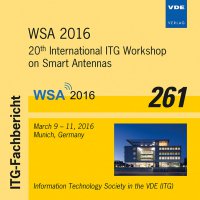Peak-to-Average-Power Reduction for FBMC-based Systems
Conference: WSA 2016 - 20th International ITG Workshop on Smart Antennas
03/09/2016 - 03/11/2016 at München, Deutschland
Proceedings: WSA 2016
Pages: 6Language: englishTyp: PDF
Personal VDE Members are entitled to a 10% discount on this title
Authors:
Eldessoki, Sameh (Fraunhofer Institute for Telecommunications, Heinrich Hertz Institute, Berlin & Institute of Communications Engineering, Ulm University, Ulm, Germany)
Dommel, Johannes; Thiele, Lars (Fraunhofer Institute for Telecommunications, Heinrich Hertz Institute, Berlin, Germany)
Hassan, Khaled (Fraunhofer Institute for Integrated Circuits (IIS), Erlangen, Germany)
Fischer, Robert F. H. (Institute of Communications Engineering, Ulm University, Ulm, Germany)
Abstract:
In this study, different peak-to-average-power-ratio (PAPR) reduction schemes proposed for OFDM are analyzed for Filter-Bank Multicarrier/Offset Quadrature Amplitude Modulation (FBMC/OQAM) systems, namely clipping, tone reservation (TR), active constellation extension (ACE), joint tone reservation and active constellation extension (TRACE) and selected mapping (SLM). A modification of selected mapping (SLM) is introduced, where the overlapping structure of FBMC/OQAM signals is exploited. Further, a novel set of schemes for PAPR reduction that can be applied to any multicarrier modulation technique called two-stage PAPR reduction is proposed. This set of schemes is found to offer similar PAPR reduction performance of clipping, however with an improved SER performance that varies depending on the complexity and the type of the used first stage. It is observed, that the PAPR reduction can benefit for FBMC by taking the specific structure of the time-domain signal into account.


